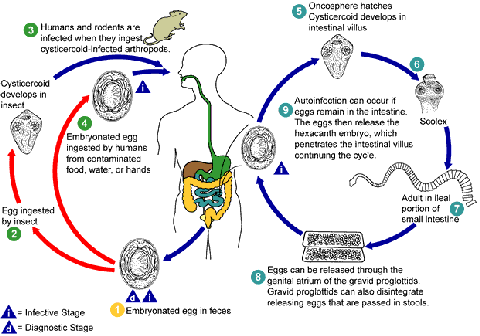Dwarf tapeworm infections occur worldwide, but is most prevalent in the southern United States. Children are frequently infected, and infections in the same family are a common occurrence.
This is a short worm, only growing 1.5 inches long at maturity with about 200 segments (proglottids). The dwarf tapeworm does not need an intermediate host, but only one mammal to host its entire life cycle. The head is small with a single ring of small hooks and four cup-shaped suckers.
The dwarf tapeworm can infect humans when the eggs are ingested from contaminated food or water, or when infected food handlers pass this parasite to others. The eggs also develop in grain beetles and many other insects, who then infect the grains that they eat. When humans eat these grains, they are also eating the parasite. Rats, mice, hamsters, and dogs can also be infected by ingesting this parasite and passing it along to humans. Most human infections result from human-to-human contact through the fecal-oral route. It is possible to be self-infected with this parasite when the eggs pass out in the stool, depending upon a person's hygiene habits.
Mild infections are usually without symptoms, but if enough worms are present, symptoms can include diarrhea, itching, abdominal pain, headaches, and other vague digestive complaints. If the infection is severe, the symptoms may present as body weakness, weight and appetite loss, insomnia, abdominal pain with or without diarrhea, vomiting, dizziness, allergies, nervous disturbances, and anemia. The infection may still be without symptoms even when the person has a heavy infestation.
Identification of the eggs in the feces is definitive. The eggs have two membranes enclosing an embryo with six hooklets.
Life Cycle Diagram (Courtesy of the DPD)

Eggs of Hymenolepis nana are immediately infective when passed with the stool and cannot survive more than
10 days in the external environment  . When eggs are ingested by an arthropod intermediate host
. When eggs are ingested by an arthropod intermediate host
 (various species of beetles and fleas may serve as intermediate hosts), they develop into cysticercoids, which can infect humans or rodents upon ingestion
(various species of beetles and fleas may serve as intermediate hosts), they develop into cysticercoids, which can infect humans or rodents upon ingestion
 and develop into adults in the small intestine. A morphologically identical variant, H. nana var. fraterna,
infects rodents and uses arthropods as intermediate hosts. When eggs are ingested
and develop into adults in the small intestine. A morphologically identical variant, H. nana var. fraterna,
infects rodents and uses arthropods as intermediate hosts. When eggs are ingested
 (in contaminated food or water or from hands contaminated with feces),
the oncospheres contained in the eggs are released. The oncospheres (hexacanth larvae) penetrate the intestinal villus and develop into cysticercoid larvae
(in contaminated food or water or from hands contaminated with feces),
the oncospheres contained in the eggs are released. The oncospheres (hexacanth larvae) penetrate the intestinal villus and develop into cysticercoid larvae
 . Upon rupture of the villus, the cysticercoids return to the intestinal lumen, evaginate their scoleces
. Upon rupture of the villus, the cysticercoids return to the intestinal lumen, evaginate their scoleces
 , attach to the intestinal mucosa and develop into adults that reside in the ileal portion of the small intestine producing
gravid proglottids
, attach to the intestinal mucosa and develop into adults that reside in the ileal portion of the small intestine producing
gravid proglottids  . Eggs are passed in the stool when released from proglottids through its genital atrium or when proglottids
disintegrate in the small intestine
. Eggs are passed in the stool when released from proglottids through its genital atrium or when proglottids
disintegrate in the small intestine  . An alternate mode of infection consists of internal autoinfection, where
the eggs release their hexacanth embryo, which penetrates the villus continuing the infective cycle without passage through the external environment
. An alternate mode of infection consists of internal autoinfection, where
the eggs release their hexacanth embryo, which penetrates the villus continuing the infective cycle without passage through the external environment
 . The life span of adult worms is 4 to 6 weeks, but internal autoinfection allows the infection to persist for years.
. The life span of adult worms is 4 to 6 weeks, but internal autoinfection allows the infection to persist for years.

